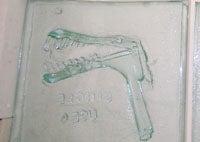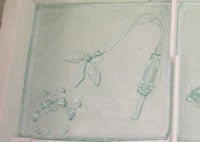Medical Waste As Informative Art

Posted in GUMC Stories
 Caroline Wellbery, M.D., an associate professor of family medicine, used to give little thought to the medical waste generated in the service of health care. But that was before Wellbery, well-known for bringing humanities into medical training at Georgetown, was asked to sit down with Erwin Timmers, a sculptural glass artist who is co-founder of the Washington Glass Studio. They met at the George Mason University SofaLab (science of art laboratory), a program designed to fuse science with art.
Caroline Wellbery, M.D., an associate professor of family medicine, used to give little thought to the medical waste generated in the service of health care. But that was before Wellbery, well-known for bringing humanities into medical training at Georgetown, was asked to sit down with Erwin Timmers, a sculptural glass artist who is co-founder of the Washington Glass Studio. They met at the George Mason University SofaLab (science of art laboratory), a program designed to fuse science with art.
Together they decided to explore an artistic representation of what could be called wasteful objects ⎯ discarded medical devices that are routinely used to improve health.
To that end, Wellbery sought the assistance of Rachel DeMunda, director of sustainability at Providence Hospital, which hosts the Georgetown Family Medicine residency program.
What she learned shocked Wellbery.
- Medical waste includes everything from unused drugs to body organs to chemotherapy and dialysis equipment to hospital bracelets. Wellbery and DeMunda learned that:
- In the U.S., there are four billion pounds of medical waste per year ⎯ the second largest contributor to landfills after the food industry.
- The operating rooms within 7,000 hospitals in the U.S. produce 20-30 percent of all medical waste.
- The health care sector accounts for eight percent of total greenhouse gas emissions in the U.S. Medical waste is the third leading source of dioxin emissions in the U.S.
- Anesthetic gases are given to 50 million patients annually. Each hour of anesthesia generates a carbon footprint equivalent to driving a car several hundred miles.
- Pharmaceutical waste can be found in soil and groundwater throughout the world.
A wake up call
 On February 25, Wellbery presented her findings in a seminar that included 16 participants, including Georgetown medical faculty and family medicine residents. This information should be part of the medical school curriculum, she says.
On February 25, Wellbery presented her findings in a seminar that included 16 participants, including Georgetown medical faculty and family medicine residents. This information should be part of the medical school curriculum, she says.
“We all need to know how big the problem of medical waste is, and how it might be possible to recycle and repurpose some of these materials,” she says. “Investigating medical waste was a real wake up call. We all need to be aware of what we are doing⎯and using.”
Wellbery then invited her seminar participants to a glass workshop designed to illustrate the issue of medical waste pollution. Nine physicians came to create glass art under the tutelage of Timmers. The resulting glass panels will go on public display on Friday, May 18 at the Smith Farm Center for Healing and the Arts, 1623 U St, NW, Washington, D.C.
Wellbery also participated in the glass workshop. She embedded a single-use plastic speculum imprinted with teeth into a glass tile ⎯ a piece she says represents the menacing, prying invasive creature that is medical waste. “It is an invasion of our bodies, affecting us internally through the toxins and carbon that impacts our breathing, our reproductive health,” she says.
Second year resident Stephen Sosnicki, M.D., created a glass tile implanted with two parallel sets of pill packs above crossed surgical instruments. “It was intended to recall the familiar skull and bones picture that represents poison,” he says. “The point is that what we call ‘medicine’ or ‘instruments’ when we are using or prescribing them immediately become hazards to others and the earth when they are discarded.”
Another tile displayed an arrangement of IV tubing that resembles a plant stalk whose leaves are wilting.
Changed by the experience
Wellbery says she and the physician participants were changed by the experience.
After the medical waste seminar, Christy Tharenos, M.D., also took a fresh look at the medical items she sees daily in her primary care clinic at the Georgetown student health center. Tharenos, who is the inaugural fellow in Georgetown’s medical humanities program, had created a glass tile from the small elastic ACE bandages she often uses. “I am particularly interested in what we put on our skin and the chemicals we are exposed to,” she says. Although the bandages are laudably re-useable, many are made of synthetic materials derived from oil, which requires a large amount of energy to produce, pumping CO2 into the atmosphere, changing the environment, she says. To this end, Tharenos imprinted a bandage into glass, hoping to convey “the complexity of a simple object and its impact on the environment and our health.”
“We are professionalized into certain procedures and protocols and are therefore somewhat oblivious to the fact that overuse of materials and careless disposal [of them] are excesses in our behaviors,” Wellbery says. But with increasing sensitivity “to the destruction of our environment, and to the costs associated with our throw away behaviors,” changes have already been made to Georgetown’s family medicine practices.
For example, eliminating patient access to the “red bag” canisters in exam rooms has substantially cut down on the expense needed to dispose of this regulated waste. “Although the red bag waste is intended for potentially infectious waste, patients were throwing diapers, and other ordinary waste, into those canisters,” she says.
“The glass workshop was a way of processing this new information, and of understanding that our profession plays a role in harming the environment, and ourselves, despite our mission to improve health,” Wellbery says.
By Renee Twombly, GUMC Communications
(Published May 9, 2012)
